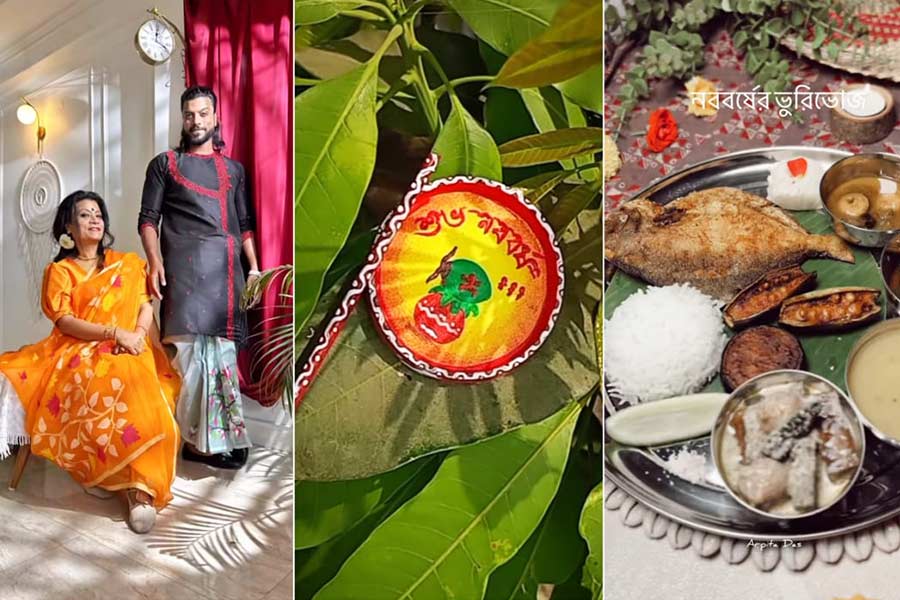As the year turns to 1431, there is a spirit of celebration in the air. On Poila Baisakh, every Bengali home welcomes the New Year. The new, crisp garments come out of the wardrobe. The sweets vanish from the trays at sweet shops. The crowd at the bazaars, the aroma at the kitchens and puja bells at every home indicate that Bengalis are celebrating the arrival of a new year. For this edition of Reels of the week, My Kolkata looks at videos on the ’gram that captures the emotions of Poila Baisakh.
Nabo Borsho means…
In a ‘Amra Bangali’ trend on Instagram, @_soumo_das sums up the true essence of the Bengali New Year. He talks about how, ahead of Poila Baisakh, people scout shopping malls and markets to buy new clothes to wear on the first day of the Bengali year. The budget is lower in comparison to Durga Puja, thanks to the ‘Chaitra Sales’ that offers hefty discounts. From garments to household essentials, people wait for the sale to purchase new items. The content creator highlights another tradition on the Bengali New Year, which is called Halkhata korte jaowa. On this day, shop owners begin their year with a fresh ledger. The customers visit the shops from where they purchase goods regularly. The shop owners offer packets of sweets and a Bengali calendar. Nabo Borsho for Bengalis means this and much more. Check out the reel.
Bengal's unique Gajan tradition
In the last week of Chaitra, Gajan is celebrated in some parts of Bengal ushering in the Bengali New Year. Devotees dress up as like their deities Shiva, Kali, Neel and Dharma by painting their faces and body. Processions are carried out and melas are organised. Gajan has a profound reflection on life, death, and rebirth. It mirrors the agricultural cycle of sowing and harvesting, and highlights the deep connection of the community with nature’s rhythms. This reel by @shutter_bong captures the colourful celebrations in the outskirts of Kolkata.
Maachh, mishti and more
If it is a Bengali festival, can food be far behind? While food is a significant part of all celebrations, on the Bengali New Year the spread is all about celebrating the culture. Fish, of course plays a significant role, not just because Bengalis love fish, but also because fish is considered auspicious in the culture. And so are sweets. Recipe content creator @weekend_flavours_ shares her Poila Baisakh spread through a reel and it is absolutely droolworthy!
Nabo Borsho nostalgia
Do you also wish your childhood memories were recorded in videos? Thanks to animators like @bongpicasso, who re-creates our childhood nostalgia of Poila Baisakh, it can be a reality. From the sizzling sounds of the kitchen, savouring of rosogollas and a lavish thali to greeting relatives in new clothes, the memories of Poila Baisakh in this animated reel gives us pure joy.
Learn draping the Athpoure sari for Poila Baisakh
The Athpoure sari draping is a traditional way of wearing a sari in Bengal. Be it in weddings or during pujas, the Athpoure drape adds the traditional aesthetic to your look. If you are planning on wearing a sari this Poila Baisakh, you may want to try this look. Need lessons on acing the drape? @boseoninsta and mother @leena.bose.3 have a detailed tutorial in their recent reel. Check it out.
Nabo Borsho craft
Are you looking for a cool new year activity for your kids? These mini hand-held traditional fans are easy to make at home. Reuse old ice-cream cups or lids and get a haatpakha made carrying the message ‘Shubho Nabo Borsho’. These are perfect for gifting purposes too. Check out this step-by-step guide by @crafter_mou.

 Suprotim Nandi (@shutter_bong)
Suprotim Nandi (@shutter_bong)
